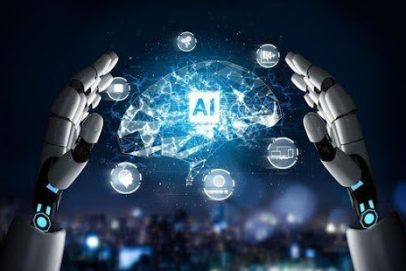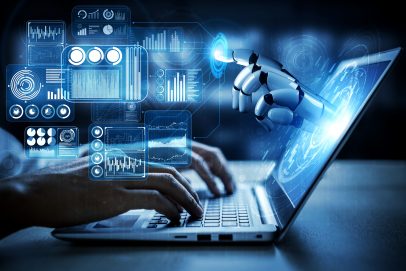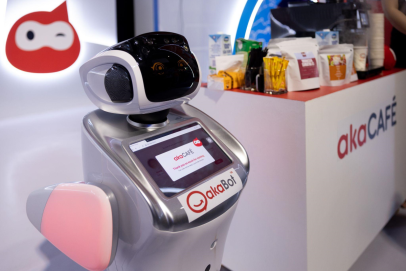Transforming the Employee Experience: Harnessing the Power of AI & Intelligent Automation
In today’s dynamic business environment, characterized by innovation and a relentless pursuit of efficiency, businesses are embracing Artificial Intelligence (AI) and Intelligent Automation (IA) to transform their operations. Yet, these advancements are not solely about streamlining workflows and reducing expenses. Instead, they’re fundamentally reshaping the way employees interact with their tasks, promoting empowerment, and catalyzing profound transformations.
1. Artificial Intelligence vs Intelligent Automation
McKinsey defines Artificial Intelligence (AI) as the capacity of machines to execute cognitive tasks typically attributed to human intelligence. On the other hand, Intelligent Automation (IA) leverages AI and Robotic Process Automation (RPA) to streamline processes and enhance operational efficiencies.
Integrating AI and IA can optimize operations, and reduce manual effort, leading to higher levels of efficiency, accuracy, and decision-making. Besides, the combination of these technologies can empower employees to proficiently manage both routine and complex cognitive tasks, expanding the scope of automation.
2. Empowering employees through AI and Intelligent Automation
McKinsey’s studies revealed that around 30% of jobs across roughly 60% of industries could be fully automated because of their dependence on manual systematic processes.
The traditional workplace model, characterized by manual processes and hierarchical structures, is giving way to a new era of agility, efficiency, and innovation. AI and IA are catalysts for this change, empowering organizations to streamline operations, enhance productivity, and unlock the full potential of their workforce. By automating routine tasks and augmenting human capabilities, AI and IA are reshaping the employee experience and driving organizational success.
Moreover, the automation of workflows, which previously demanded traditional, costly, and skilled developers, is now accessible to everyone. Consequently, as businesses accelerate their digital transformation journey, employees can have the opportunity to dedicate their time to nurturing and refining their creative, analytical, and communicative abilities, rather than being trapped in repetitive manual duties (Gartner, 2020).
According to the Qualtrics 2024 EX Trends Report, there is a growing acceptance of AI in the workplace, with 53% of engaged employees expressing comfort with AI. Furthermore, senior employees and C-suite executives are increasingly open to leveraging AI technologies, indicating a positive shift in attitudes towards these transformative tools.
3. The shift towards empowerment
Workplace empowerment involves enabling individuals to take control over their tasks, make independent decisions, and unlock their complete potential. However, with the integration of AI and IA, empowerment evolves into a new realm. Here, employees utilize advanced technologies to enhance their cognitive capabilities, streamline workflows, and leverage innovation.
3.1. Streamlining routine tasks
AI and IA are proficient at automating monotonous and repetitive tasks, enabling employees to reallocate their time and effort toward more significant tasks. Through the automation of manual processes like data entry and document processing, employees can focus on tasks that demand human judgment, creativity, and critical thinking.
3.2. Improving decision-making and problem-solving capabilities
AI algorithms can scrutinize complex datasets, recognize patterns, and produce insights that equip employees to make well-informed decisions and tackle problems with greater efficiency.
3.3. Augmenting creativity and innovation
Far from replacing human creativity, intelligent systems can serve as catalysts for innovation by facilitating ideation sessions and providing personalized recommendations based on user preferences. Through techniques such as natural language processing (NLP) and Generative AI models, employees can explore new possibilities and push the boundaries of conventional thinking.
3.4. Boosting creativity and fostering innovation
Sophisticated systems can spur innovation by aiding in brainstorming sessions and delivering customized suggestions tailored to user preferences. Utilizing methods like Natural Language Processing (NLP) and Generative AI models, employees can explore new possibilities of development and thinking.
3.5. Promoting learning and growth
Learning platforms powered by AI provide tailored training modules, adaptable evaluations, and engaging simulations that align with individual learning preferences and styles. Through the analysis of learners’ performance data and behavioral patterns, AI can offer customized interventions, monitor progress, and suggest relevant content, empowering employees to acquire new skills.
AI-driven learning platforms offer personalized training modules, adaptable evaluations, and immersive simulations tailored to match individual learning preferences and styles. By analyzing performance data and behavioral patterns, AI can deliver personalized interventions, track progress, and recommend relevant content, enabling employees to develop new skills effectively.
3.6. Customizing the employee journey
AI can also be utilized to customize the employee experience. From personalized learning initiatives and development programs to AI-guided performance evaluations and career guidance, organizations can harness AI to shape a more tailored and captivating workplace environment. By acknowledging and appreciating individual contributions, organizations can cultivate a sense of belonging and empowerment that enhances employee satisfaction and retention.
3.7. Fostering collaboration and innovation
AI and IA can break down silos and facilitate collaboration among teams by automating repetitive tasks, optimizing workflows, and offering advanced communication tools. This allows employees to collaborate more effectively across geographical boundaries, nurturing a culture of teamwork and knowledge exchange. Moreover, AI-generated insights and predictive analytics can stimulate innovation by detecting emerging trends, revealing potential opportunities, and assisting in strategic decision-making.
4. Overcoming challenges and harnessing opportunities
While the advantages of AI and IA are evident, organizations encounter several hurdles to fully exploit their potential:
- Cultural transformation: The adoption of AI and IA requires a transformation in organizational culture, wherein employees are motivated to embrace change, explore emerging technologies, and consistently evolve. Leaders are key to making this shift happen. They need to demonstrate the desired behaviors, offer support, and create an environment where innovation and teamwork are valued.
- Ethical considerations: As AI becomes more prevalent in workplaces, organizations need to tackle ethical issues like safeguarding data privacy, addressing algorithmic bias, and ensuring the ethical use of AI technologies. Creating strong governance structures and promoting transparency and accountability can help minimize ethical risks, building trust among employees and stakeholders.
- Skills gap: The fast-paced evolution of technology has resulted in a growing skill disparity, leaving numerous employees needing more technical knowledge to harness AI and IA efficiently. To address this issue, organizations need to invest in programs focused on retraining and enhancing the skills of their workforce, guaranteeing their continued relevance and adaptability in an era dominated by advanced technologies.
5. Case study: Driving success with akaBot’s automation solutions
The case study below demonstrates how a leading digital bank in Vietnam can drive success, optimize human resources, and improve employee efficiency with akaBot’s automation solutions.
Challenges
- The demand for undisruptive operation and optimized operations while achieving cost-cutting efficiencies
- Heavy workload of repetitive and manual tasks in the banking sector requiring high accuracy levels and interaction with other complex systems
- The demand for comprehensive automation of the whole business within a short period
Solution
Realizing that automation can help to solve complex challenges, the bank decided to choose akaBot’s solutions from FPT to transform the operation and enhance employee productivity. Automation implementation was delivered to 200+ processes at 9 divisions within the organization.
Results
The akaBot application helped ensure 24/7 continuous operation, reducing error rates by 98%, and automating up to 30% of current tasks. Hence, by automating routine tasks, optimizing workflows, and eliminating bottlenecks, akabot’s automation solutions can empower employees to accomplish more in less time, thereby enhancing operational efficiency and productivity across the organization.
6. Embracing the Future of Work
AI and Intelligent Automation possess the potential to transform the workplace by empowering employees, boosting productivity, and fostering innovation. Through the integration of these technologies into business operations and investment in employee training and development, organizations can establish a collaborative environment where humans and machines work together towards common objectives. Embracing the transformative capabilities of AI and IA is crucial not only for maintaining competitiveness in today’s digital landscape but also for shaping a future where employees are empowered to unleash their full potential.
| Exclusive article by FPT IS expert
Bui Dinh Giap CEO of akaBot |













